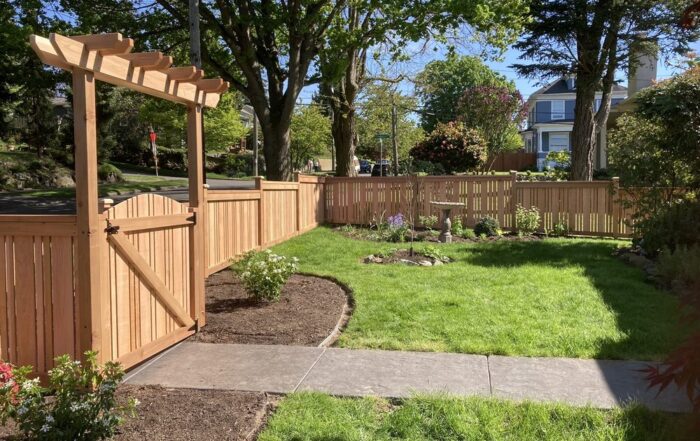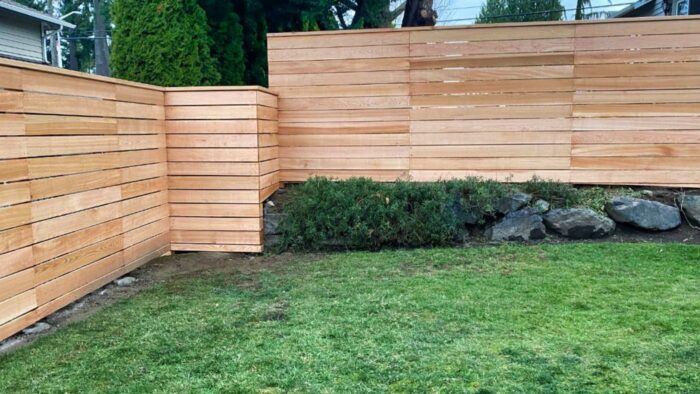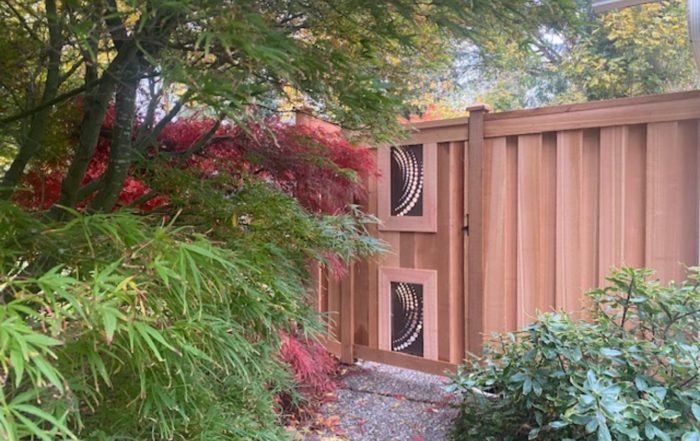Deciding between horizontal and vertical fences for your home? Explore our expert guide to understand the key differences, including aesthetic appeal, installation costs, and suitability for your landscape. Make an informed choice to enhance your property's style and functionality.
When it comes to wood fencing types, your choices affect more than just your yard’s boundaries. Whether you value privacy, durability, or design, each fence type offers unique benefits and challenges. This concise guide provides you with the essential knowledge needed to navigate your options, from charming picket fences to sturdy privacy barriers. Find out which wood types and maintenance practices will make the most sense for you without any unnecessary fluff.
Key Takeaways
- Wood fences come in various styles such as picket, privacy, and horizontal plank fences, suitable for different aesthetics and functional needs, like enhancing curb appeal or ensuring privacy.
- The right type of wood is critical for a fence’s longevity and aesthetics, with cedar being naturally durable and repellent to insects, while pressure-treated pine offers affordability and robust protection.
- Maintaining a wood fence requires regular cleaning, sealing, and staining to protect against elements and potential damage, while also potentially increasing the property’s value.
Exploring Popular Wood Fence Styles
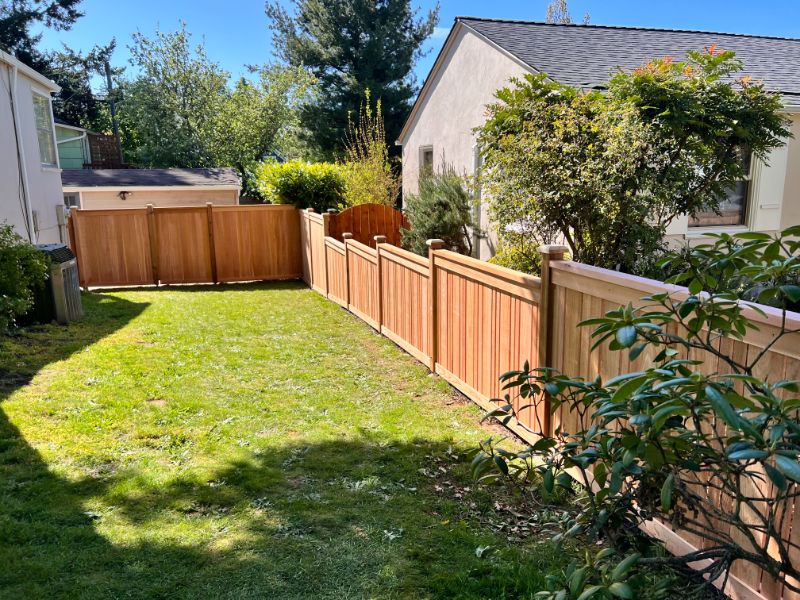
The popular full panel style fence
From the white picket dreams of suburban homes to the stately horizontal lines of urban retreats, wood fence styles are as varied as they are versatile. Among the various types of wood fences, whether you’re looking to enhance privacy, curb appeal, or just keep the pets in the yard, there’s a wood fence to meet every need and taste. Some popular wood fence styles include:
- Traditional picket fence
- Privacy fence
- Shadowbox fence
- Split rail fence
- Lattice fence
Consider your specific needs and the overall aesthetic of your home when choosing a wood fence style.
Let’s take a stroll down the garden path and peek over some of the most popular styles that homeowners adore.
Classic Picket Fences: Timeless Charm
The classic picket fence, with its iconic pointed tips, is a symbol of Americana that never goes out of style. It’s more than just a demarcation of space; it’s a statement of timeless charm that boosts curb appeal and warmly welcomes visitors.
Beyond aesthetics, picket fences serve the practical purpose of keeping pets corralled without obstructing the view from within or without.
Horizontal Plank Fences: Modern Elegance
For those with a penchant for contemporary design, horizontal plank fences offer clean lines and a sleek profile, thanks to the use of horizontal rails. These modern barriers don’t just protect privacy; they do it with panache. The horizontal fence layout can be customized with various stains, ensuring your fence is not only a shield from prying eyes but also a reflection of your personal style.
Rustic Split Rail Fences: Countryside Aesthetic
Evoking the spirit of the countryside, rustic split rail fences capture the heart with their simple construction and historical roots. While they may not offer the privacy of other styles, they excel at marking property lines with a nod to pastoral beauty. This is the fence of choice for those looking to add a touch of bucolic charm to their landscape, similar to the post and rail fence.
Understanding Different Wood Fence Types
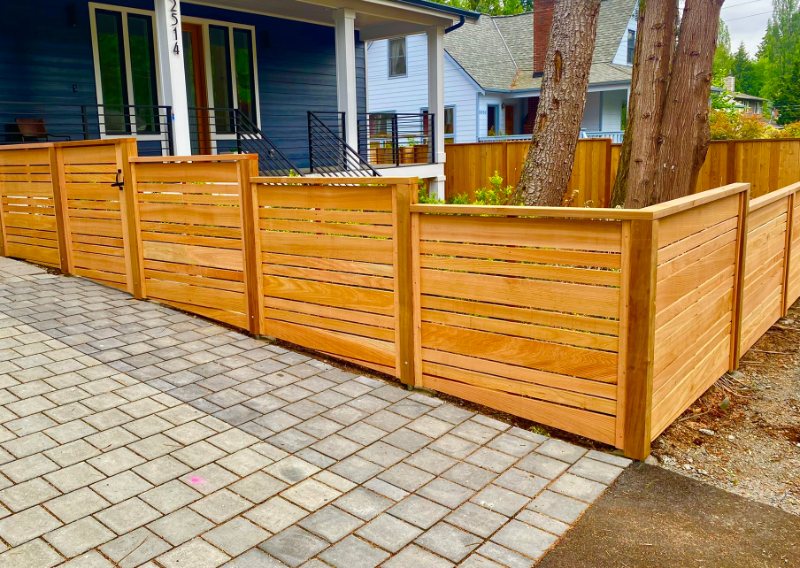
The modern horizontal style fence perfectly accentuates Seattle’s craftsman style architecture
Beyond the common picket and plank, the world of wood fencing is rich with diversity. From the solid embrace of board-on-board fences to the airy lightness of lattice, each type offers unique benefits that cater to various preferences. Let’s delve into the details of these wood fence types and discover which might be the right fit for your homestead.
Board on Board Fences: Ultimate Privacy
For those seeking the ultimate in privacy, board on board fences are the fortress of choice. Their overlapping design ensures not a single peek is possible, and they stand as sturdy protectors against wind, noise, and the curious gaze of neighbors. A well-constructed board on board fence can provide the perfect balance between aesthetics and functionality, making them ideal privacy fences.
These horizontal fences are not only practical but also aesthetically pleasing, forming a solid wall that can be tailored to any height or color.
Lattice Fencing: Decorative Touches
Lattice fencing, with its crisscrossed strips, adds a decorative flair to any garden. It’s the perfect backdrop for climbing roses or ivy, creating a living wall that breathes life into your space. While it may not offer the solidity of a board on board, it provides a charming compromise between openness and security – a trellis for nature’s beauty and a barrier for the garden beyond.
Shadowbox Fences: Aesthetic and Functionality Combined
The shadowbox fence is a masterclass in combining aesthetics with functionality. Its unique design, featuring alternating panels on either side of the central rail, creates a pattern that plays with light and shadow. This type of fence offers privacy without feeling too enclosed, allowing breezes to pass through while still obstructing direct views, making it an excellent choice for those who value both seclusion and openness.
Selecting the Right Wood for Your Fence
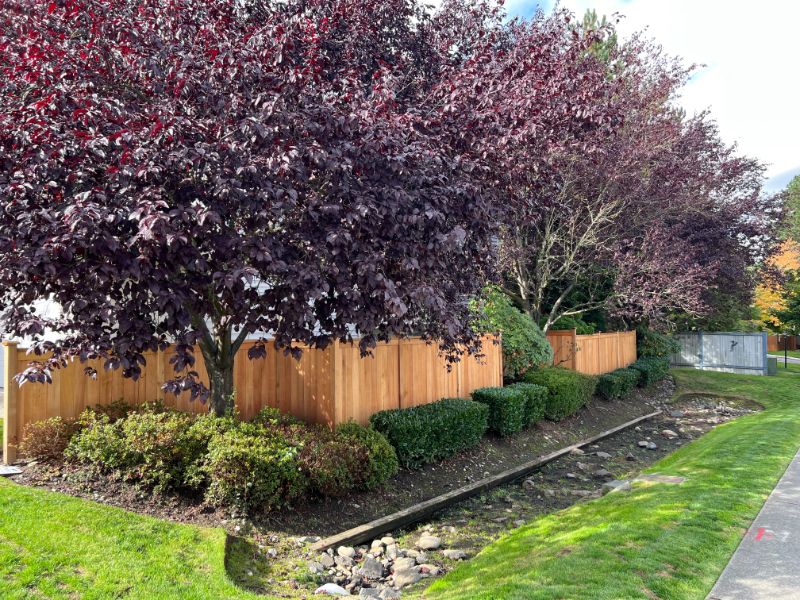
A modified panel cedar fence selected for it’s resilience to weather
Choosing the best wood for your fence is about more than just appearance; it’s about finding the perfect balance between durability, maintenance, and sustainability. From the sturdy cedar to the resilient pressure-treated pine, each wood type brings its own set of benefits to the table. Let’s explore some of the most popular options to help you decide which one aligns with your fencing goals.
Cedar: Natural Beauty and Durability
Cedar stands out in the forest of options with its natural beauty and innate durability. This wood type is imbued with oils that repel insects and resist decay, ensuring your fence’s longevity even in the dampest of climates. Cedar’s rich texture and warm tones provide a stunning natural finish that often requires no additional staining – a true testament to its allure.
But cedar’s benefits don’t stop at its striking appearance. It is also an eco-friendly choice, reducing the need for chemical treatments and preserving the environment. And while cedar may come at a higher initial cost, its long-lasting nature proves to be a cost-effective investment over time, especially when you consider its ability to enhance property value with its premium aesthetics.
Pressure Treated Pine: Budget-Friendly Option
For the budget-conscious homeowner, pressure-treated pine offers a robust alternative without breaking the bank. This workhorse of the wood fence world is treated to resist rot and deter pests, ensuring your fence stands the test of time.
While it may lack the natural elegance of cedar, it more than makes up for it in practical resilience and affordability.
Redwood and White Oak: Premium Selections
On the higher end of the spectrum, redwood and white oak are the connoisseurs’ choice for wood fencing. Redwood’s rich, reddish hues and resistance to decay make it a sought-after material for those looking to make a statement. While these premium woods come at a higher price, their longevity and timeless appeal justify the investment for many homeowners.
Design Considerations for Wood Fences
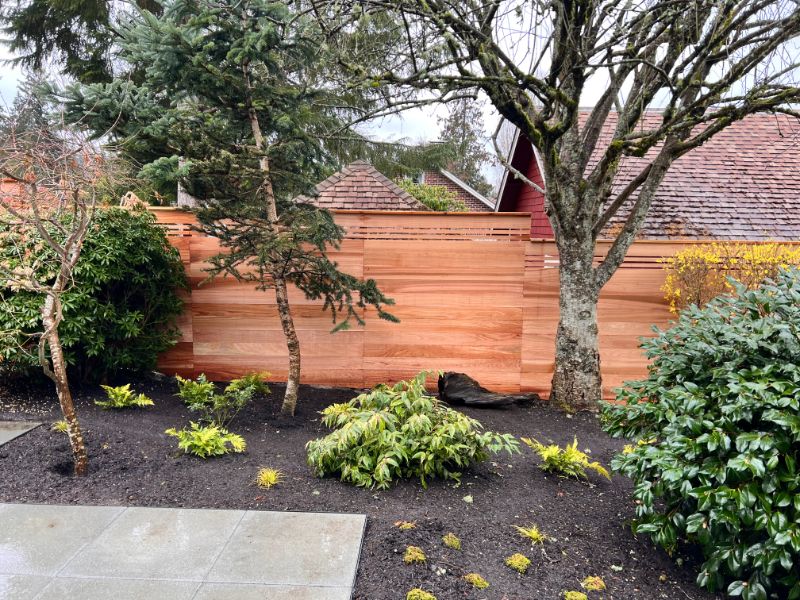
Horizontal wood fence customized to accent landscape
Designing a wood fence is an art form that combines functional needs with aesthetic desires. The right design considerations can turn a simple fence into a statement piece that complements your home and landscape. From the height of the panels to the hues that tie into your home’s exterior, each decision contributes to the harmony of your outdoor living space.
Fence Height: Balancing Privacy and Regulations
When it comes to fence height, it’s about finding the sweet spot between your desire for privacy and compliance with local zoning regulations. While a towering barrier may keep nosy neighbors at bay, it’s important to ensure that your fence height selections are within legal limits, to avoid any compliance issues down the road.
Color Variations: Matching Your Home’s Exterior
A fence should be a natural extension of your home, and choosing the right color is key to achieving this seamless transition. Whether you’re looking to match the trim of your Victorian abode or create a stark contrast for your minimalist dwelling, the right stain or paint can turn your fence into an integral part of your home’s aesthetic.
Layout Options: Customizing for Sloped Landscapes
Not all landscapes are created equal, and sloped terrains require a creative approach to fence design. Whether you opt for the stepped charm of a terraced layout or the flowing lines of a contoured fence, the goal is to work with the land, not against it, ensuring stability and visual appeal regardless of the incline.
Enhancing Your Fence with Additional Features
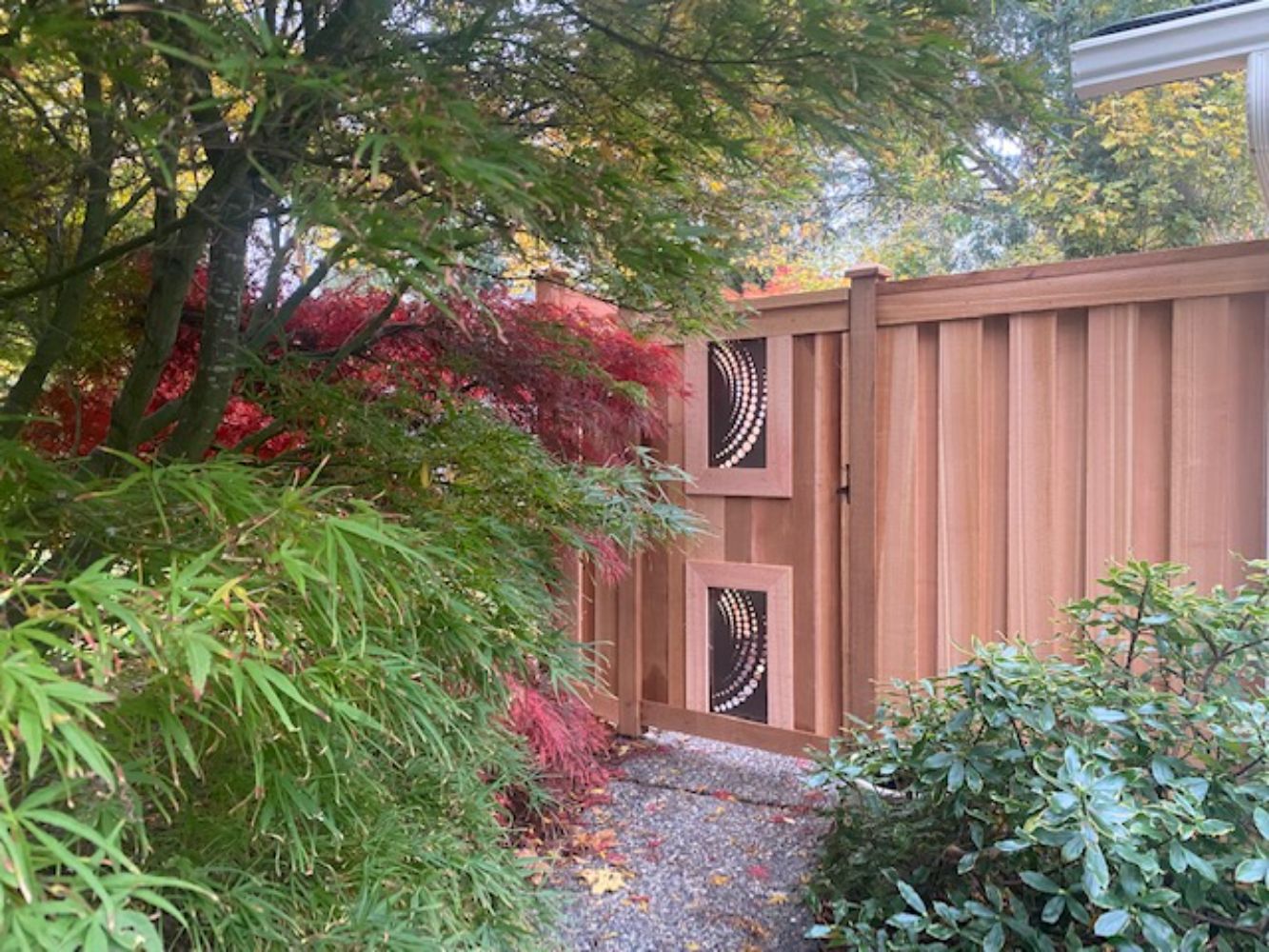
Enhancements for wood fences can include custom metal etchings
A wood fence can be much more than a perimeter marker; it can be a canvas for personal expression. Enhancing your fence with additional features can transform it from a simple boundary into a standout feature of your property.
Let’s explore some of the ways you can elevate your fence from functional to fabulous.
Gates and Access Points: Seamless Integration
A gate is more than just a point of entry; it’s the welcoming embrace to your private sanctuary. When designed with thought and care, gates can reflect the style and character of the fence and the home it surrounds, offering both convenience and a harmonious aesthetic.
Post Caps and Trim: Finishing Touches
Post caps serve as the crowning jewels of your fence, not only protecting the vulnerable tops of your posts from the elements but also adding a touch of elegance.
Whether you choose a classic wooden design or a more ornate metal accent, the right post cap can elevate the entire look of your fence.
Climbing Plants and Lattice Accents: Nature’s Decor
The addition of lattice accents and climbing plants can bring a verdant flourish to your wood fencing, weaving a tapestry of greenery that enhances privacy and beauty.
Trellises provide the perfect structure for flowering vines to ascend, creating a living wall that changes with the seasons and breathes life into your outdoor space.
Maintenance Tips for Wood Fences
A well-maintained wood fence can serve as a sturdy and beautiful boundary for decades. With the right maintenance regimen, you can protect your investment and enjoy the privacy and beauty it provides for many years to come. Let’s dive into some essential maintenance tips that will keep your fence looking its best.
Regular Cleaning and Inspection
Routine cleaning and inspection are the cornerstones of wood fence maintenance. Keeping your fence clear of debris and regularly checking for signs of damage will go a long way in preserving its integrity.
A gentle wash with a low-pressure hose or a simple sweep can make a world of difference in the fight against rot and insect damage.
Sealing and Staining: Protecting Against the Elements
Sealing and staining your wood fence are crucial steps in shielding it from the harshness of the elements. A quality sealant not only prolongs the life of your fence but also maintains its natural beauty, while staining can add a splash of color and additional protection against sun and rain.
Repair and Replacement Strategies
When wear and tear take their toll, having a strategy for repair and replacement is key. Addressing issues like splintering or warping promptly can prevent further damage, ensuring that your fence remains a strong and attractive feature of your property for as long as possible.
Summary
We’ve journeyed through the realm of wood fences, from the quaint charm of picket fences to the robust security of board-on-board designs. Along the way, we’ve considered the nuances of wood selection, the subtleties of design, and the importance of maintenance. Whether you’re seeking privacy, beauty, or both, the right wood fence can deliver – and with the insights from this guide, you’re well-equipped to make an informed choice that will enhance your home for years to come.
Frequently Asked Questions
How often should I inspect and clean my wood fence?
You should inspect and clean your wood fence at least once a year, or more often if it’s exposed to harsh weather conditions. Keeping it well-maintained will help extend its lifespan.
Can I customize the height of my wood fence?
Yes, you can customize the height of your wood fence, but make sure to check local zoning laws for any height restrictions.
What is the best wood for a long-lasting fence?
The best wood for a long-lasting fence is cedar or redwood, known for their natural resistance to decay and insects, which can last over 20 years with proper care.
Are there eco-friendly options for wood fencing?
Yes, choosing sustainably sourced or reclaimed lumber, or woods like cedar which don’t need chemical treatments, are eco-friendly options for wood fencing.
How do I choose the right design for my wood fence?
To choose the right design for your wood fence, consider your home’s aesthetic, privacy needs, and land topography. It’s also helpful to consult with a professional for a design that meets your preferences and is structurally sound.

